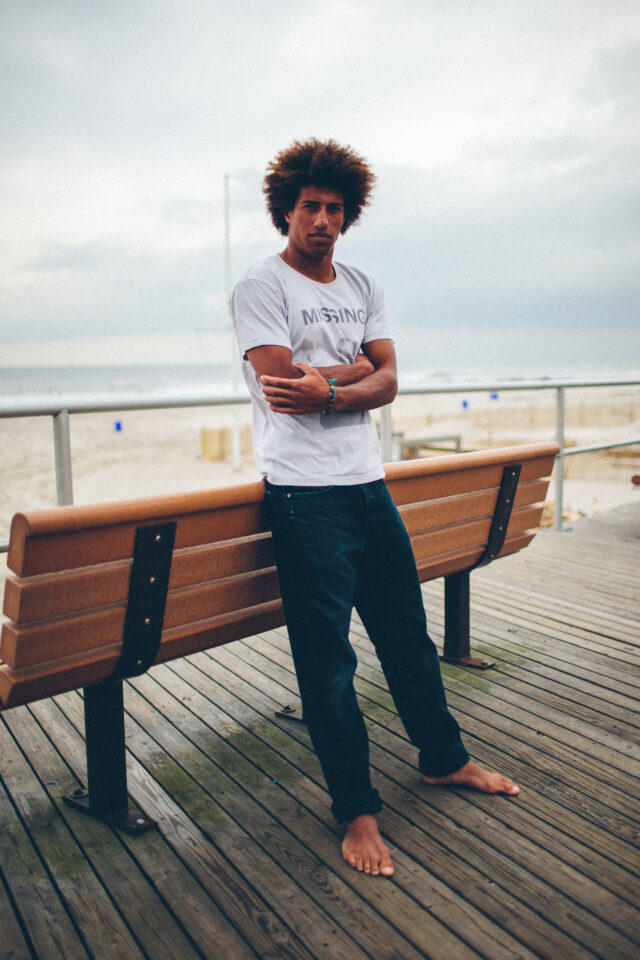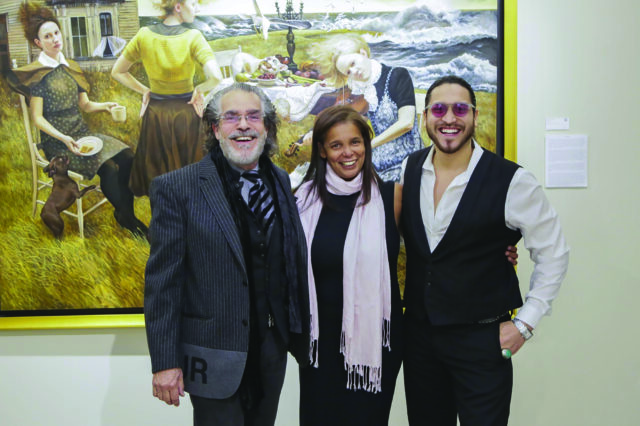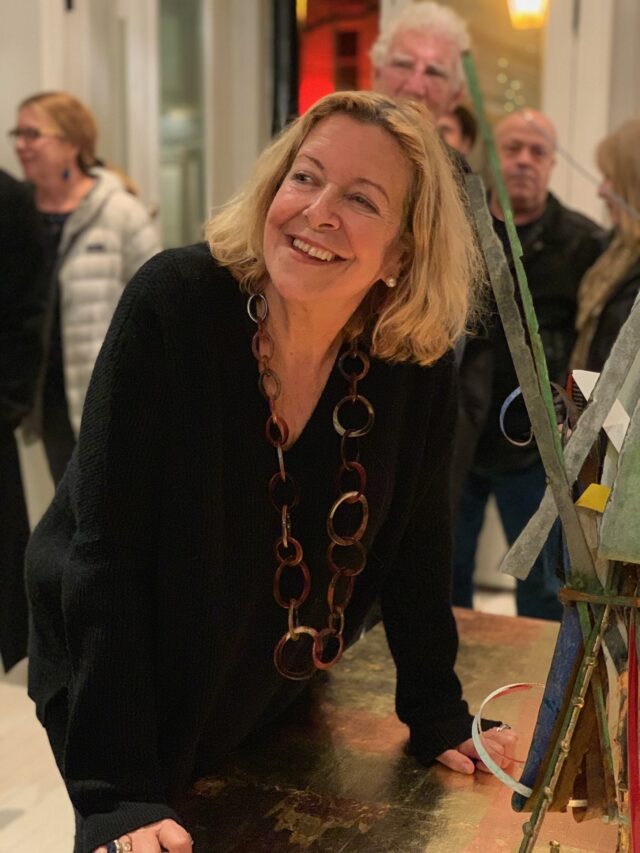
Meet art world wave maker Tripoli Patterson, the man behind Tripoli Gallery in Wainscott.
CURATORIAL GUIDING PRINCIPLE
“Authenticity is the most important thing I’m looking for in an artist—that their works are true to their souls; they’re connected. There has to be that internal connection.”
AUSPICIOUS DEBUT
“I curated my first art show when I was 20 years old; it featured Lola Schnabel, John Ross Rist, Angelbert Metoyer and Tin Ojeda, four artists who were all from very different walks of life. Seeing the results of that first show pushed me forward.”
THE NEXT WAVE
“As a surfer, I was competing a lot in my amateur career, leading up to traveling to Australia to compete in the world qualifying series when I was 19. With poor results in both of the two starting events on the Australian leg, and surfing in some of the worst conditions, as I was yet to be a seeded competitor, I became uninspired and wanted to put myself on the other side where I would never lose; rather, I’d create the events that invited all types of talent. I started to get a glimpse of my gallery. I realized I never wanted to put myself in a situation where so much of my energy and time is dependent on judges’ decisions, or the conditions of the wave. There are so many different things that can affect my end result. I decided that I wanted to create the platform that would host the storyboard through the visions of all of the artists, and in creating that platform, there my energy would be directed.”
A FAMILY AFFAIR
“My brother [artist Yung Jake] has been making art since I can remember. When my mom [Terry Patterson] was doing surf contests and directing the New York District for the Eastern Surfing Association, she’d have Jake do little drawings in the newsletters. I have a painting of Jake’s that he made when he was 4 years old. It’s very in sync
with the cartoon he created for Cartoon Network.”
HISTORICAL PERSPECTIVE
“Viewing art is one of the things that separates us from other species in the world. We’re living in a time where we’re pushed so much imagery and so much content by corporations with an agenda. Scenes on the news, or from Hollywood or advertising, have such a wide range of reasons they’re being shown to us, influencing us to do something. Artists don’t want you to do anything except get a glimpse into their minds and encourage you to maybe look into your own. We start learning our history through the different perspectives of all of the artists that we’ve been with and surrounded by. It becomes the true proof that our generation was here, and the ones before ours. Artists peel back the artificial skin that society lays on, and give us a glimpse underneath the surface to help and encourage us to look at something differently.”
THE POWER OF REPRESENTATION
“I’m mixed. My mom’s white and my dad’s Black. The responsibility I have as a mixed person is to be a bridge and influence, and maintain a camaraderie between all races; being a role model to all my predecessors of all mixed races and exposing them to the arts and international artists that we work with. It’s always been something in the back of my mind, and something I have to remind myself about: How many Black artists am I showing and representing? The same way I wouldn’t want to start off being a surf gallery, or a Black art [dealer] gallery, I want to develop the Tripoli Gallery as an unbiased one that’s not based on my color. You would never think of Tripoli Gallery as a Black gallery. It’s [just] an art gallery. Now that I’ve established the gallery, I have to make decisions about who I’m showing. An equal representation of female artists is extremely important
to me, as well.
But it’s definitely something I’m still learning and dealing with. Still wanting to have an open mind. It’s something that’s very current right now. It’s tough too, because people can use it to manipulate their agendas. So they use this very loaded subject, and a lot of times the core point of using it is to get something else done.”
LIVING THE DREAM
“Art reminds us to look within, look at things passing through our brains, and to remember to dream. Artists are dreamers and our dreams can come true. If they’re sincere and you put energy and work toward them, they will. My dream is to find a healthy balance between work and play; to have platforms and galleries around the world so I can continue to do this. To mix cultures and bring people I grew up with here to Australia, for example, and vice versa. Opening up borders and increasing the cross-pollinations of the world, letting the conversation get a wider base. The wider the perspective can be on the topic of us, the better we understand ourselves. I want to widen the stage, and make it as big as I can. I’d love to have four surf trips a year. And also have galleries in all of these places, like the Hamptons, where the surf is next door—Australia, Tel Aviv, Kauai, Bali…. Anywhere I open a gallery, there has to be surf within an hour’s drive or less.”
MAKING A SPLASH
“Mary Heilmann helped me curate my current exhibition and she titled it ‘Six Hot and Glassy,’ a surf term that she remembers from the ’60s, and the show starts off with two works by Herbie Fletcher of painted photographs of Buzzy Trent and George Downing surfing Makaha, Hawaii, from his family archives. I’ve waited 15 years to do a surf show because I have always sort of had my two worlds separated so as to not get classified. A lot of artists relate to surfing, because they take similar paths. The most important thing is the journey of the mission. It’s not like there is this individual end goal; it’s one wave to the next.”
NEW HORIZONS
“I had my gallery on Jobs Lane in Southampton for 10 years. My new landlord decided to build a commercial space with 18-foot ceilings, four huge garage doors, eight high windows for gorgeous natural light, and radiant heated floors: the ideal canvas for an art gallery. Maybe he was tapping into a frequency he got from his adolescent years when he was stretching canvases for Willem de Kooning in Springs. My godmother, Lisa de Kooning, helped me open the gallery on Jobs Lane, so I love that synchronicity. I wanted a bigger space. I wanted to do more and show bigger work, have something more connected to the pulse of the artist and less connected to the shoppers and buyers of a Main Street space. I wanted it to be a destination. A space where artists can really inspire and create. I want to do residencies here.
This space is a stage for me to do whatever I want. The plywood walls make it a little bit more casual, more inviting. I want everyone to feel invited here.”
26 Ardsley Rd., Wainscott; tripoligallery.com —as told to Ray Rogers

Meet Mago, gallery curator at Bridgehampton’s RJD Gallery, who brings a passion for
magical realism to the East End.
STREET CRED
“I’m what you’d call an ‘outside insider’—without any formal art education, I was catapulted into the art world. I was born in NYC, and raised and educated in Colombia. Magical realism is a real thing there, with writers and artists like Gabriel García Márquez and Fernando Botero. Art is very, very rich there. Returning to New York, I worked in fashion, in production. At 17, I was a graffiti artist in NYC in the early ’90s scene, influenced by the club world. I’m an artist at heart, a trance avant-garde graffiti artist.”
GALLERY TENURE
“When I was introduced to the collector Richard Demato, founder of RJD Gallery, which has an emphasis on magical realism, we clicked. I’ve been with the gallery for five years now. Our works are all over the world—the heads of banks, CEOs of Netflix and Uber, all of these powerful people, have a major collectorship. They know they can get museum-quality works from RJD Gallery.”
FALL FINDS
“We picked up on a trend we call ‘Big Art, Small Canvas.’ This is our fifth year in a row of showcasing well-priced, diverse, small artworks in the fall and winter season—it’s a great way to appreciate a loved one, to give an everlasting gift of art, or to fill up small open spaces in your home, or build a collection. Think salon-style hanging—pair multiple techniques and mediums, from photography to oil painting. There’s a lot of magic to that. We travel the world and bring back little finds.”
CELEBRATING DIVERSITY
“We are an international gallery, specializing in emerging to mid-career artists, and as a result there is a tremendous amount of diversity among our artists, who include Armando Valero, a Colombian magical realist and poet; Philip Smallwood, a Black American artist who paints watercolors on paper; Salvatore Alessi, an Italian contemporary surrealist; Suzy Smith, who is a painter in the American realist tradition. And our February show always celebrates Black History month—this is our 10th year.”
KEEPING ZEN
“I’m a huge fan of body tapping yoga at Harlem Brain (harlembrain.com).”
HAMPTONS CALLING
“I was at an artist-writer dinner about 20 years ago in the Hamptons, where I met other gentlemen artists and I thought, I could aspire to be them! The soil here is very rich in creativity. It nurtures creative souls. In art history, the US has mid-century art as a real point of entry into the art world. And that all happened here on the East End, with artists like Jackson Pollock and Willem de Kooning in East Hampton, and Andy Warhol in Montauk. Coming here felt like a pivotal point in my life—somehow I knew that I would always have this connection to this land.”
2385 Main St., Bridgehampton; rjdgallery.com —as told to Ray Rogers

Meet Julie Keyes, contemporary art connoisseur and owner of Keyes Gallery in Sag Harbor.
EAST END ORIGINS
“I was always a visual person. I came to Southampton College and found the fantastic art community with de Kooning, Pollock, Howard Kanovitz and Larry Rivers. I moved around and worked in Colorado and Boston. But I always found this area perfect. The landscape and seascape are unbelievable and the art is so sophisticated and glamorous. I came back with this huge fantasy about how fantastic Sag Harbor is—and it’s lived up to it.”
HUMBLE BEGINNINGS
“I had a ceramics factory selling to Bergdorf Goodman and Neiman Marcus, and wholesale is so nickel-and-dime. I just wasn’t good at money. The space had a gallery on the first floor, and the gallery was paying for the ceramics business. I curated for hotels, then we started doing shows. The subtle and insignificant turns you’d never expect pushed me toward where I am now and solidified my business. I flew by the seat of my pants. I did this without a dollar, and there was a point where I was waitressing at night and working at the Sag Harbor gallery during the day.”
MOVING UP
“We’re lucky to work with artists who are coming up. We’re constantly improving with ferocious self-editing. Our forte is to build a collection that doubles in value. In terms of hotels, our first project was the Mandarin Oriental, then The Beverly Hills Hotel, and Dubai’s Burj Khalifa, the tallest building in the world. We’re currently working on The Breakers Palm Beach.”
THE PSYCHOLOGY OF ART
“I believe houses in the Hamptons should host the killers of the art world. You see what colors and styles people gravitate toward and the elements of their space. You need the ability to read a client. You must hit a home run in the first three selections to show that you ‘get them’. The right work will redirect a room’s energy to meditative, happy, or even sad. Red elements will make the room hot. Blues and yellows will turn it cold. For example, a living room must have comfort, like a stuffed animal filled with ice cream!”
PRIORITIZING INCLUSIVITY
“I’ve always been supported by good artists who have honored me with the opportunity to represent them. It’s one thing to sell work, and another to forward a career. Claude Lawrence is a great example of an artist of color that checks every box for collection. He’s a master at color, abstraction and has everything going for him. He’s good as a long-term financial decision to purchase his work. Kim Joon has great stuff; huge, wild 3-D photographs.”
WELLNESS ESSENTIALS
“I ride my horse every morning. I meditate. I walk my dogs. We have a ritual that’s very important. We have a garden and make lunch with our vegetables every day at the gallery.”
45 Main St., Sag Harbor, juliekeyesart.com —as told to Gabrielle Echevarrieta





